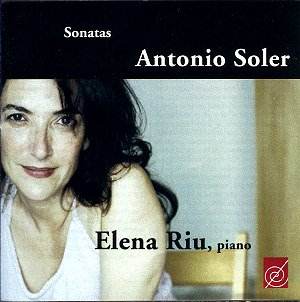Antonio Soler was perhaps
one of Domenico Scarlattiís most gifted
and later famous students. Soler, who
took holy orders in the middle of his
life to enable him to dedicate all of
his time to the creation and performance
of music, was one of the most important
composers of the Spanish Baroque. Highly
favored by the Infante Don Gabriel,
son of King Carlos III, Soler was a
tireless worker who was reported to
have only slept four hours each day
in order to allow himself more time
to compose. The prolific Padre left
behind hundreds of works. There are
multiple Magnificats, masses, psalm
settings, and Officia defunctorum
in addition to the famous quintets,
and more than one hundred solo sonatas
for the harpsichord.
This sampling of a
dozen of the keyboard sonatas gives
strong evidence of the tremendous influence
that Scarlatti had over his pupil. However,
these are far more than mere imitations,
and are delightful in their melodic
invention and harmonic color. They also
belie Solerís own dazzling keyboard
technique. These are works of considerable
demands on the performer, rife with
rapid cross-hand passages and intricate
scale work. The dance like rhythms,
particularly in slower sonatas such
as no. 87 would prove to be models upon
which Josef Haydn would in part base
his own keyboard works.
Purists might squawk
at the performance of these works on
the modern grand, but Soler was known
to have been familiar with the early
forte-piano, and some of the published
editions of his sonatas indicate that
either harpsichord or piano are acceptable.
To these ears, they work splendidly
as piano pieces, and the more modern
instrument is capable of bringing Solerís
colorful harmonies and intricate contrapuntal
textures to the fore through its ability
to vary color, attack and dynamics to
a greater degree than the rather monochromatic
harpsichord.
Elena Riu is a pianist
with a complete command of her instrument,
yet she is not a virtuoso for its own
sake. She is the servant of the music,
and clearly has an affinity for the
intricacies of Solerís musical language.
Her playing is elegant and extremely
clean, and her choices for tempi are
always just right. One never feels rushed
when listening, and although some of
the music is quite fast indeed, the
listener is never left gasping for breath.
She has a wonderful cantabile and is
able to make the music dance and
sing at the same time. She is possessed
of a rich palette of colors and chooses
her musical brushes with both care and
taste.
The rich and reverberant
acoustic in which these performances
were captured is lovely to experience.
There is just the right amount of resonance
in this recording and the microphones
are placed just right in order to capture
both the power and articulation of the
piano as well to give the sound a warm
bloom.
Program notes in three
languages are thorough, although I would
have liked more discussion of the music
recorded on the disc than I got. The
typo, which dated an eighteenth century
musical treatise as having been written
in 1972, was a bit laughable, but this
occurs only in the English portion of
the booklet. Although the cover photo
of Ms. Riu is attractive enough, I am
not drawn to this disc for the beauty
of its cover art. It is indeed rather
mundane, and the fact that a biography
of the performer is missing is pretty
inexcusable.
This is a nice alternative
to harpsichord performances of this
music, and is a nice add-on to the collections
of those who enjoy hearing Murray Periaha
or Andras Schiff play baroque works
on the modern grand. Lovely music splendidly
played. Recommended.
Kevin Sutton
